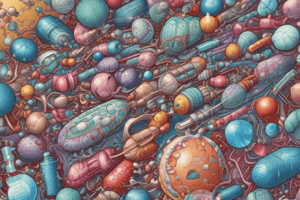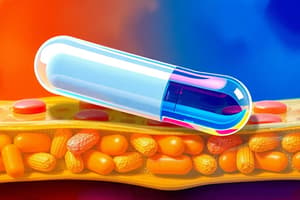Podcast
Questions and Answers
What is the primary purpose of excess drug in transdermal delivery systems (TDDS)?
What is the primary purpose of excess drug in transdermal delivery systems (TDDS)?
- To decrease the rate of drug absorption.
- To minimize skin irritation from the adhesive.
- To replace the drug more frequently than recommended.
- To ensure continuous drug availability and absorption. (correct)
Which feature distinguishes reservoir systems from other transdermal delivery systems?
Which feature distinguishes reservoir systems from other transdermal delivery systems?
- They use a solid drug form for storage.
- They provide an immediate burst of drug upon application.
- They contain multiple small reservoirs of drug. (correct)
- They include a single large reservoir for the drug.
In what way do reservoir systems typically deliver drugs compared to monolithic systems?
In what way do reservoir systems typically deliver drugs compared to monolithic systems?
- They have a simpler design and construction process.
- They provide an inconsistent drug release.
- They involve a non-controlled rate of release.
- They result in a more consistent drug delivery. (correct)
How are most reservoir systems constructed?
How are most reservoir systems constructed?
What is one characteristic of micro-reservoir systems in reservoir TDDS?
What is one characteristic of micro-reservoir systems in reservoir TDDS?
What is one of the main advantages of iontophoresis as a delivery method?
What is one of the main advantages of iontophoresis as a delivery method?
Which of the following is a disadvantage of iontophoresis?
Which of the following is a disadvantage of iontophoresis?
How can iontophoresis enhance patient compliance?
How can iontophoresis enhance patient compliance?
What can help minimize the skin irritation caused by iontophoresis?
What can help minimize the skin irritation caused by iontophoresis?
What is a significant drawback of the iontophoresis delivery method regarding drug absorption?
What is a significant drawback of the iontophoresis delivery method regarding drug absorption?
What is the primary indication for transdermal nicotine products?
What is the primary indication for transdermal nicotine products?
Which of the following transdermal systems uses a reservoir type?
Which of the following transdermal systems uses a reservoir type?
What is a common dosing frequency for transdermal oxybutynin?
What is a common dosing frequency for transdermal oxybutynin?
Which product is indicated for the treatment of moderate to severe restless legs syndrome?
Which product is indicated for the treatment of moderate to severe restless legs syndrome?
What advantage does transdermal drug delivery systems (TDDS) offer in terms of drug compliance?
What advantage does transdermal drug delivery systems (TDDS) offer in terms of drug compliance?
Which transdermal product is currently in development?
Which transdermal product is currently in development?
What is a significant disadvantage of transdermal drug delivery systems?
What is a significant disadvantage of transdermal drug delivery systems?
For which condition is transdermal selegiline indicated?
For which condition is transdermal selegiline indicated?
What is the primary indication for the fentanyl iontophoretic transdermal system (IONSYS)?
What is the primary indication for the fentanyl iontophoretic transdermal system (IONSYS)?
What must be done before initiating treatment with the iontophoretic transdermal system?
What must be done before initiating treatment with the iontophoretic transdermal system?
Which of the following is a common use for iontophoresis in veterinary medicine?
Which of the following is a common use for iontophoresis in veterinary medicine?
What is an important formulation factor for sonophoresis?
What is an important formulation factor for sonophoresis?
Which agent is commonly delivered using iontophoresis for inflammation treatment?
Which agent is commonly delivered using iontophoresis for inflammation treatment?
What is the mechanism of action of sonophoresis?
What is the mechanism of action of sonophoresis?
What type of drug formulation is typically used with sonophoresis?
What type of drug formulation is typically used with sonophoresis?
Which one of the following statements about pilocarpine iontophoresis is accurate?
Which one of the following statements about pilocarpine iontophoresis is accurate?
What is a primary benefit of photodynamic therapy?
What is a primary benefit of photodynamic therapy?
What is a major limitation of the laser light used in photodynamic therapy?
What is a major limitation of the laser light used in photodynamic therapy?
Which of the following is an adverse effect of photodynamic therapy?
Which of the following is an adverse effect of photodynamic therapy?
Which of the following is a non-cancer use for photodynamic therapy?
Which of the following is a non-cancer use for photodynamic therapy?
What is the primary mode of cancer identification in photodynamic therapy?
What is the primary mode of cancer identification in photodynamic therapy?
How is Aminolevulinic acid administered when used for actinic keratosis?
How is Aminolevulinic acid administered when used for actinic keratosis?
What role do micropores play in drug delivery techniques?
What role do micropores play in drug delivery techniques?
What type of drug delivery method uses tiny needles to pierce the skin?
What type of drug delivery method uses tiny needles to pierce the skin?
What type of light is primarily used in photodynamic therapy?
What type of light is primarily used in photodynamic therapy?
Which of the following is a potential side effect of treatment with Visudyne®?
Which of the following is a potential side effect of treatment with Visudyne®?
How is Cysview® administered for bladder cancer detection?
How is Cysview® administered for bladder cancer detection?
What is electroporation primarily used for?
What is electroporation primarily used for?
Which condition is treated with Photofrin®?
Which condition is treated with Photofrin®?
Which of the following is a disadvantage of photodynamic therapy?
Which of the following is a disadvantage of photodynamic therapy?
Flashcards are hidden until you start studying
Study Notes
Transdermal Drug Delivery Systems (TDDS)
- TDDS contain an excess of drug within the system to ensure continued drug saturation in the stratum corneum
- TDDS allow for a slower decrease in drug delivery rate compared to systems without excess drug
- Most TDDS designs include a drug-releasing capacity exceeding the recommended replacement timeframe
- Fresh TDDS are used to replace used ones on a schedule
Types of TDDS: Reservoir
- Reservoir systems (membrane-controlled systems) contain a drug reservoir (pouch, typically in liquid or gel form), a rate-controlling membrane, backing, adhesive, and protective layers
- A small amount of drug in the adhesive layer is frequently used to initiate prompt absorption
- Reservoir systems offer a more-consistent drug release profile compared to monolithic systems
- Reservoir systems can be manufactured by pre-constructing the delivery unit, filling the reservoir, and sealing; or by a lamination process (continuous construction, dosing, and sealing)
- Micro-reservoir systems are a subcategory of reservoir systems containing several small reservoirs of drug enclosed between backing and a rate-controlling membrane
Membrane-Controlled Transdermal Systems (Reservoir Systems)
- Can result in contact dermatitis after application to the skin
- Can contain some drug within the adhesive layer for “immediate” delivery
- Often result in a more consistent drug delivery as compared to monolithic systems
Examples of Transdermal Drug Delivery Systems
- Transderm-Nitro (TDDS): Reservoir system, used for the delivery of Nitroglycerin
- Nicoderm: Reservoir system, used for nicotine replacement therapy
- Exelon: Matrix system, used for the delivery of rivastigmine (treatment of Alzheimer's disease)
- Emsam: Matrix system, used for the delivery of selegiline (treatment of major depressive disorder)
- Oxytrol: Matrix system, used for the delivery of oxybutynin (treatment of urge incontinence)
- Lidoderm: Reservoir system, used for the delivery of lidocaine (relief of pain associated with postherpetic neuralgia)
- Neupro: Matrix system, used for the delivery of rotigotine (moderate to severe restless legs syndrome and Parkinson's disease)
- TEP: (Transferred Epithelial Patch): Matrix system, used for the delivery of ibuprofen
Advantages of TDDS
- Produce more uniform blood levels than conventional oral products
- Can maintain plasma levels over a longer duration
- Reduces adverse effects
- Extends the activity of drugs having short half-lives
- Improves compliance
- Avoids GI absorption problems (not affected by food interaction, GI tract pH)
- Avoids the first pass effect
- Provides an alternative to oral administration (for patients experiencing nausea/vomiting)
- Non-invasive, convenient, and user-friendly
- Easy to identify medication in emergencies
- Drug therapy may be terminated rapidly by removing the TDDS
Disadvantages of TDDS
- Only relatively potent drugs may be used due to skin impermeability
- Biological factors such as skin thickness, skin permeability, and the presence of pores on skin surfaces can affect drug delivery.
Physical Absorption Enhancers: Iontophoresis
-
Advantages:*
-
Control delivery rates by varying current density, pulsed voltage, drug concentration, and ionic strength
-
Allows large, charged molecules to be delivered to the patient
-
Avoids GI incompatibility, erratic absorption, and first-pass metabolism
-
Reduces adverse effects
-
Reduces inter-patient variability
-
Avoids continuous injection and infusion risks (infection, inflammation, fibrosis)
-
Enhances patient compliance with a convenient and non-invasive therapeutic regimen
-
Disadvantages:*
-
Can lead to skin irritation at high current densities (burns can result from improper placement)
-
Lag time between administration and drug reaching the bloodstream
-
Products:*
-
IONSYS: Fentanyl iontophoretic transdermal system, used for the short-term management of acute post-operative pain
-
Lidocaine IP products (LidoSite, NumbyStuff): topical anesthetic for the needle-phobic
-
Other Uses:*
-
Iontophoresis of pilocarpine: Induce sweating in the diagnosis of cystic fibrosis
-
Topical delivery of fluoride to teeth
-
Dexamethasone: delivered directly into joints
-
Delivery of NSAIDs, corticosteroids, anti-inflammatory agents, antibiotics, and local anesthetics for veterinary use
-
Being investigated for protein delivery
Physical Absorption Enhancers: Sonophoresis (Phonophoresis)
- High-frequency ultrasound used to transport drug across the skin
- Drug is mixed with a coupling agent (gel, ointment, cream)
- Ultrasonic energy transferred from the phonophoresis device to the skin through the coupling agent
- Thought to disrupt the lipids in the stratum corneum, increasing skin penetrability
Formulation Factors for Sonophoresis
- Vehicle must be smooth and non-gritty
- Vehicle should have relatively low viscosity
- Avoid air incorporation
Photodynamic Therapy (PDT)
- Light-activated drug is applied topically or injected intravenously
- Drug accumulates in the affected tissue
- Low power light delivered through a PDT device is focused on the affected tissue
- Light activates the photo-reactive drug, releasing agents that destroy only affected cells
- Most applications use light waves in the visible light spectrum (350-800 nm range)
Advantages of PDT:
- Avoids first pass effect
- Causes minimal damage to healthy tissues
Disadvantages of PDT:
- Current laser light can only pass through ~3 cm of tissue
- Makes skin and eyes sensitive to light for 6+ weeks following treatment
- Other potential adverse effects: nausea, vomiting, metallic taste in the mouth
Uses of PDT :
- Cancer diagnosis: Abnormal cells take up the compound differently than normal cells
- Cancer therapy: Primarily used to treat tumors on or just under the skin, or on the lining of internal organs using endoscopes and fiber optic catheters
- Non-cancer applications: Age-related macular degeneration, psoriasis, actinic keratoses, severe acne (in clinical trials)
Approved Photodynamic Therapy Products:
- Levulan: Aminolevulinic acid, used to treat actinic keratosis
- Kerastick: ALA, used to treat warty overgrowths of the skin
- Photofrin: Porfimer sodium, used to treat esophageal cancer, endobronchial non-small cell lung cancer, and Barrett’s esophagus
- Cysview: Hexaminolevulinate HCl, used to visualize bladder cancers during cystoscopy
- Visudyne: Verteporfin, used to treat age-related macular degeneration, psoriasis, and rheumatoid arthritis (unlabeled use)
Other Techniques:
- Microporation: Creation of micropores in the stratum corneum, achieved by electroporation, microneedles, ultrasound, radiofrequency, and lasers
- Electroporation: High voltage pulse applied to the skin for a short period, leading to increased permeability of the stratum corneum and formation of pores
- Microneedle or Microprojection-Based Devices: Tiny drug-coated projections or needles pierce the top layer of skin, creating superficial holes for drug transport
- Transdermal Patches: Drug delivery system that provides controlled release of medication through the skin.
Summary
- Transdermal drug delivery systems (TDDS) provide a convenient and non-invasive route for medication administration.
- They offer advantages such as sustained drug release, reduced adverse effects, and improved patient compliance.
- TDDS are particularly beneficial for drugs with short half-lives, those experiencing first pass effects, or those who have difficulty with oral absorption.
- Techniques such as iontophoresis, sonophoresis, and photodynamic therapy employ physical absorption enhancers to facilitate drug penetration through the skin.
- Microporation, using methods like electroporation and microneedles, disrupts the stratum corneum to enhance drug transport.
- TDDS are continually evolving, with new products and techniques under development to address a wide range of medical conditions.
Studying That Suits You
Use AI to generate personalized quizzes and flashcards to suit your learning preferences.




